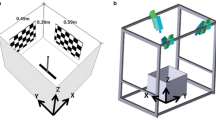Abstract
-
1.
Male Poecilobothrus nobilitatus show two distinct kinds of pursuit. Females are “shadowed” at a distance of a few cm, using both rotational and lateral movements. Other males are chased, in a pursuit that involves only rotation and fast forward flight. The rotational component of pursuit appears to have the same control system in both types of tracking, and it is best described as a continuous translation of the error angle between the direction of the target and the pursuing fly's body axis into the pursuing fly's angular velocity. The constant of proportionality is 30–40°·s−1 per degree, and the delay in the system is about 15 ms. Pursuit on the ground is 2–3 times slower than in flight, although the delay seems to be similar.
-
2.
Attempts were made to see whether the aerial pursuits could be modelled effectively by a saccadic or discontinuous control system, as suggested for Musca pursuit (Wagner 1986). It was found that the velocity profiles of the chases could be fitted by an overlapping series of plausible saccade-like events, However, the correlation between visual information (error angle and error angular velocity) available just before each fictive saccade correlated poorly with saccade peak velocity. It is thus concluded that Poedlobothrus pursuit is basically continuous in nature, but it is argued that the two types of mechanism are hard to distinguish in natural behaviour.
Similar content being viewed by others
References
Bastock M (1967) Courtship. Heinemann, London
Buchner E (1984) Behavioural analysis of spatial vision in insects. In: Ali MA (ed) Photoreception and vision in invertebrates. Plenum, New York, pp 561–621
Carpenter RHS (1988) Movements of the eyes. Pion, London
Collett TS, Land MF (1975) Visual control of flight behaviour in the hoverfly Syritta pipiens L. J Comp Physiol 99:1–66
Collett TS, Land MF (1978) How hoverflies compute intersection courses. J Comp Physiol 125:191–204
Colyer CN, Hammond CO (1968) Flies of the British Isles. 2nd ed. Warne & Co, London
Egelhaaf M (1987) Dynamic properties of two control systems underlying visually guided turning in house-flies. J Comp Physiol A 161:777–783
Gilbert C, Strausfeld NJ (1991) The functional organization of malespecific visual neurons in flies. J Comp Physiol A 169:395–411
Hardie RC (1983) Projection and connectivity of sex-specific photoreceptors in the compound eye of the male housefly (Musca domestica). Cell Tissue Res 233:1–21
Hardie RC, Franceschini N, Ribi W, Kirschfeld K (1981) Distribution and properties of sex-specific photoreceptors in the fly Musca domestica. J Comp Physiol 145:139–152
Hassenstein B (1971) Information and control in the living organism. Chapman & Hall, London
Hausen K, Strausfeld NJ (1980) Sexually dimorphic interneuron arrangements in the fly visual system. Proc R Soc Lond B 208:57–71
Land MF (1989) Variations in the structure and design of compound eyes. In: Stavenga DG, Hardie R (eds) Facets of vision. Springer Berlin, pp 90–111
Land MF (1993) The visual control of courtship behaviour in the fly Poecilobothrus nobilitatus. J Comp Physiol A 173:595–603
Land MF, Collett TS (1974) Chasing behaviour of houseflies (Fannia canicularis). A description and analysis. J Comp Physiol 89:331–357
Reichardt W, Poggio T (1976) Visual control of orientation behaviour in the fly. Part I. A quantitative analysis. Q Rev Biol 9:311–375
Reichardt W, Poggio T (1981) Visual control of flight in flies. In: Reichardt W, Poggio T (eds) Theoretical approaches in neurobiology. MIT Press, Cambridge Mass., pp 135–150
Srinivasan MD, Bernard GD (1977) The pursuit response of the housefly and its interaction with the optomotor response. J Comp Physiol 115:101–117
Strausfeld NJ (1991) Structural organization of male-specific visual neurons in calliphorid optic lobes. J Comp Physiol A 169:379–393
Vogel G (1957) Verhaltensphysiologische Untersuchungen über die den Weibchenbesprung des Stubenfliegen-Männchens (Musca domestica) auslösenden optischen Faktoren. Z Tierpsychol 14:309–323
Wagner H (1986) Flight performance and visual control of flight of the free-flying housefly (Musca domestica L.) II. Pursuit of targets. Phil Trans R Soc Lond B 312:553–579
Wehrhahn C (1979) Sex specific differences in the orientation behaviour of houseflies. Biol Cybern 32:239–241
Zeil J (1983) Sexual dimorphism in the visual system of flies: the free flight behaviour of male Bibionidae (Diptera). J Comp Physiol 150:395–412




